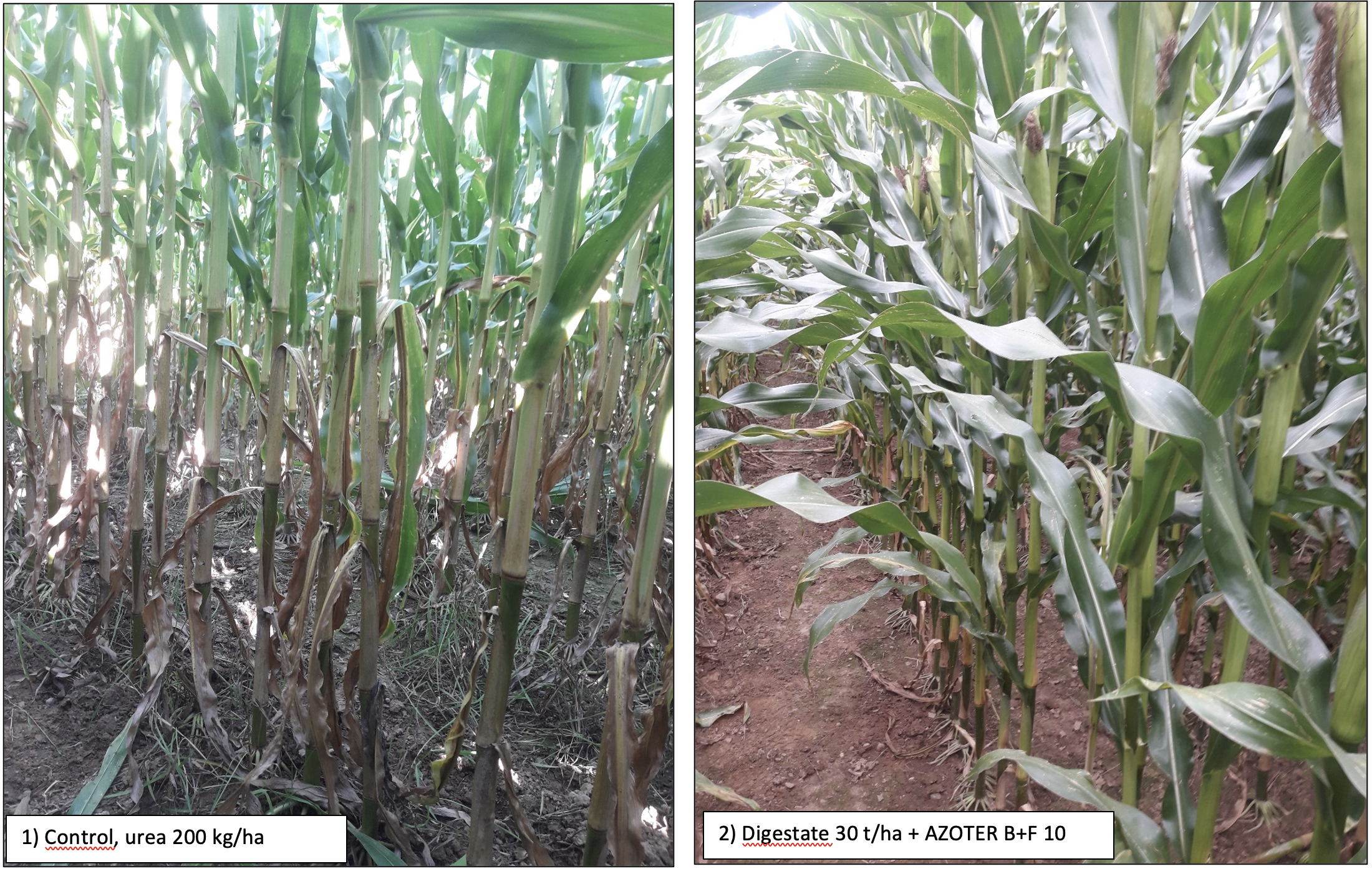![]()

Verification of the effectiveness of AZOTER B+F soil bacteria fertilizer in the plant stand of maize for silage in the soil and climatic conditions of The Bohemian–Moravian Highlands
Report of results from semi-operational experiments from 2021 from soil treated with soil adjuvant (PPL) in the form of concentrated AZOTER B bacteria fertilizer (containing Pseudomonas putida bacteria) with separate additive F (Trichoderma atroviride parasitic fungus) for application of digestate from biogas plant in maize silage cultivation technology
* * *
Ing. Tomáš Javor, DiS., Ing. Lenka Beranová, DiS. a kol., AGROEKO Žamberk spol. s r.o.
Josef Hamsa, Martina Dirbáková a kol., ZOD Habry
Jiří Řezníček, AZOTER CZ s.r.o.
Characteristics of the experiment: Verification of the AZOTER B + F bacteria fertilizer at a dose of 10 l / ha (and additive F at a dose of 0,1 l / ha) was performed in the agrochemical deficient soils of the Bohemian-Moravian Highlands, in the cadastral area of Habra (Havlíčkův Brod). Typical medium heavy to light soil with mild to medium skeletal additive occured on the experimental plot. The soil type on the plot was cambisol mesobasic (acidified) on gneisses and other solid rocks. The climate region is slightly warm, humid. The average altitude of the plot is 484 m. The preceding crop of the maize was the grain and the subsequent intercrop. The termination of the intercrop stand was in the autumn by plowing it together with the applied cattle manure at a dose of 40 t / ha. In the spring, after the manure application, the soil showed a favorable slightly acidic soil ph, a higher level of low mineral nitrogen content (Nmin), acceptable lower level of available phosphorus content and potassium content, reduced and acceptable level of calcium and magnesium content. The content of microelements was sufficient (iron -Fe and manganese -Mn increased) and the content of high-risk aluminum (Al) was very high. This was due to the reduced content of available phosphorus, which was the main deficient element in the soil. With the basic fertilization at a dose of 120 kg N / ha (Table 1), the nitrogen content (Nmin) moved from small to medium.
| pH | Nmin. | P | K | Ca | Mg |
| CaCl2 | mg/kg of soil | ||||
| 6,01 | 10,79 | 60 | 235 | 1793 | 152 |
| Slightly acidic | Low | Acceptable | Good | Acceptable | Acceptable |
| Al | Fe | Mn | Zn | Cu | |
| mg/kg of soil | |||||
| 900 | 251 | 99 | 2,80 | 2,54 | |
| Very high | Good | Good | Good | Good | |
Tab. 1. Agrochemical properties of soil on the plot before fertilizers application and AZOTER B + F bacteria fertilizer (Habry, April 28, 2021)
The variants of the operational experiment were based on standard fertilization of the soil with nitrogen in the mineral concentrated urea fertilizer (46% N) and on farm fertilization with organic fertilizer with fast-releasing nitrogen, ie. digestate from the biogas plant. The increase in the fertilizing effect of the relatively organically stabilized digestate with AZOTER B+F bacteria fertilizer (soil adjuvant) was verified. The reduction of digestate doses in the maize stand to make microbial release of nitrogen, phosphorus, potassium and microelements (zinc) more intensive by the original soil bacteria, which were purposefully delivered by the concentrated AZOTER B + fertilizer, has been verified:
Control, 1) urea application of 200 kg/ha
(without soil treatment to support the release of nutrients with AZOTER B+F fertilizer, supply of 92 kg N/ha),
Variant treatment, 2) AZOTER B+F application in a dose of 10+0,1 l/ha and application of digestate in a dose of 30 t/ha
(reduction of nitrogen supply = 12 %),
Variant treatment, 3) AZOTER B+F application in a dose of 10+0,1 l/ha and application of digestate in a dose of 20 t/ha
(digestate dose reduction = 33 %,nitrogen supply reduction = 41 %),
Variant treatment, 4) AZOTER B+F application in a dose of 10+0,1 l/ha and application of digestate in a dose of 12 t/ha
(digestate dose reduction = 60 %, nitrogen supply reduction = 65 %).
Nitrogen supply in the maize stand was carried out by standard application of urea (46% N) before sowing, in a dose of 200 kg / ha (92 kg N / ha). Another source of nitrogen supply was the use of digestate from the biogas plant after separation. The separated digestate (fugate) was applied at a standard dose of 30 t / ha (81 kg N / ha), at a reduced dose by 33% (20 t / ha = 54 kg N / ha) and by 60% (12 t / ha = 32 kg N / ha). Immediately before the application of the digestate, AZOTER B bacteria fertilizer was applied at a dose of 10 l / ha, supplemented in the liquid fertilizer with F component at a dose of 0.1 l / ha. The bacterial fertilizer was applied by a standard sprayer used for ground spraying, added to water 400 l/ ha, and maintaining a maximum allowable working pressure of 2,5 bar. The applied AZOTER B + F bacterial fertilizer was immediately incorporated with shear gate. After the subsequent digestate application (and after the application of urea on the control plot), the supplementary application of nitrogen and sulfur in a single dose of ammonium sulphate (Lovogran) was carried out just before sowing.
From the total applied nitrogen in digestates, there was 41% of nitrogen in the directly available (easily nitrifiable) ammonium (N-NH4 +) form. The remaining nitrogen in the digestate was bound in organic compounds. Their release was specifically supported by soil treatment with AZOTER B fertilizer containing, besides others, the active saprotrophic soil bacterium Pseudomonas Putida, which increases the release of nutrients from the soil or from applied organic (digestate) and livestock fertilizers (manure). The bacterium is the original component of soil edaphon and the supply of the soil restores its vitality and abundance. After decomposition of dead organic matter, the availability of nitrogen, phosphorus, potassium, and microelements (Zn) for the root zone of plants is increasing. The addition of F component represents the addition of the parasitic fungus Trichoderma Atroviride, which destroys the spores of fungi of Fusarium genus (it reduces Pythium, Rhizoctonia and Botrytis) and it enhances the effect of the preparation in decomposing of hemicelluloses and celluloses that are in post-harvest residues and straw manure (Table 2).
| Indicator: | Dry matter | Organ. substance | Ntot. | N-NH4 | P (P2O5) | K (K2O) | pH | Application of Ntotal
(digestate + Lovogran) |
| Content (%): | 3,70 | 2,78 | 0,27 | 0,11 | 0,083 | 0,25 | 8,26 | – |
| Vnos dose | t/ha | kg/ha | – | – | ||||
| 30 t/ha | 1,11 | 0,83 | 81 | 33 | 25 | 75 | – | 165 |
| 20 t/ha | 0,74 | 0,56 | 54 | 22 | 17 | 50 | – | 138 |
| 12 t/ha | 0,44 | 0,33 | 32 | 13 | 10 | 30 | – | 116 |
Tab. 2. Composition of liquid organic fertilizer digestate from biogas plant applied before sowing and after previous application of AZOTER B + F bacterial fertilizer and nutrient input performed by the applied dose and total nitrogen dose for plant stand (Habry, 28. 4. 2021)
The results of AZOTER B + F bacterial fertilizer application in the technology of digestate fertilization and effects of accessible nutrients on the soil supply, plant nutritional status, yield and quality of maize silage for production:
The dynamics of mineral forms of nitrogen (Nmin.) content after the application of standard nitrogen fertilizer – urea, showed a significant increase in the soil supply on the 34th day after its application (June 16). An extremely good supply of Nmin in the soil was found after urea application (111 mg / kg). After organic fertilizer digestate application in a full dose of 30 t / ha, Nmin supply in soil was by 42 mg / kg lower than after applying standard urea fertilization. After application of a reduced dose of digestate of 12 t / ha, Nmin content in the soil was by 58 mg / kg lower than after urea application and by 16 mg / kg lower than after application of the full dose of digestate 30 t / ha. Despite AZOTER B + F application to support microbial activity and nitrogen release, a lower releasability of acceptable Nmin to the soil from digestate was evident. On the other hand, positive preservation of supplied nitrogen in more stable organic compounds for later release during the long maize vegetation was evident. According to the diagnostic evaluation, the soil supply with Nmin for maize stand with the developed 4th – 5th leaf was completely sufficient (very good supply), already after a significantly reduced dose of digestate to 12 t / ha. At this time, the soil showed a low moisture content, and a soil crust has been formed after intensive precipitation in May, which may have limited microbial mineralization activity. However, soil conditions were suitable for the subsequent process of nitrogen changes in the soil, particularly intensive nitrification. The released nitrates (N-NO3-) formed the main proportion of mineral nitrogen (Nmin.) in the soil. The microbial releasability of nitrogen in the soil was significantly faster than nitrogen uptake of the plant stands that were limited at that time by a dry spell.
Significant decreases in Nmin content (low level) in the soil were found 69 days after the application of AZOTER B + F bacterial fertilizer and the pre-sowing dose of fertilizers (July 21). After nitrogen application in the standard fertilizer, Nmin content was 9 mg / kg (low supply). After digestate application in a dose of 30 t / ha, Nmin content was by 2.5 mg / kg lower (low supply). After a digestate dose of 12 t / ha, Nmin content was by 4.2 mg / kg lower (very low to low supply). Nmin. supply on all variants it was low and already limited for further nutrition of the stands at that time. Another nutrition of the stands was ensured by the continuing intensive growth of roots into the deeper horizons of the soil profile, where there is another source – nitrogen (eg from nitrate leaching, N-NO3-).
At the end of the vegetation (September 30), 140 days after applying AZOTER B + F bacterial fertilizer and other fertilizers, the decrease in Nmin content in the soil persisted from the period of intensive stand growth in July. However, it was evident, that the supply of Nmin in the soil after urea application and without nitrogen release support, was the lowest 6.1 mg / kg (low supply). After application of a full dose of digestate 30 t / ha, Nmin content was 12.6 mg / kg (medium supply). After a reduced dose of digestate to 12 t / ha, Nmin content was 10.9 mg / kg (low to medium supply). It was evident, that the supply of Nmin in the soil after digestate fertilization with supported release of nutrients with AZOTER B + F fertilizer, increased at the end the vegetation and it could support the use of nitrogen for grain formation. After standard urea fertilization, the Nmin supply was already soil residue (unusable residue) with minimal coverage of the final needs of the stand (Graph 1).
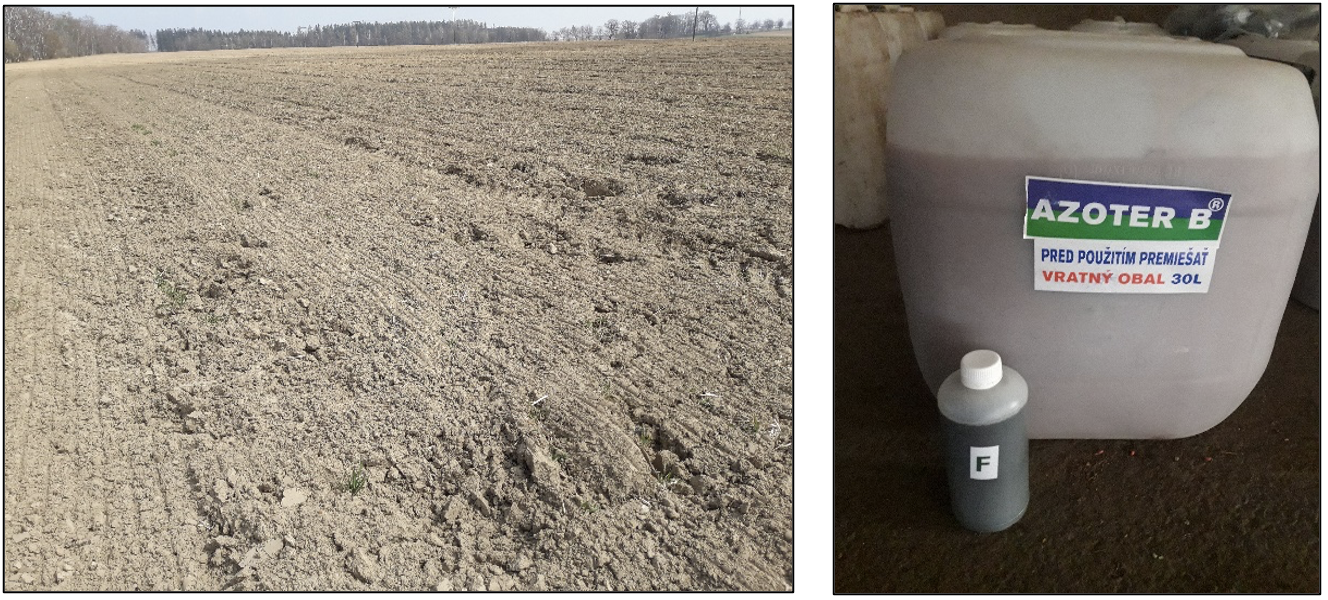
Levelled land for the application of AZOTER B + F bacterial fertilizer before the subsequent application of the digestate (Habry, April 28, 2021)
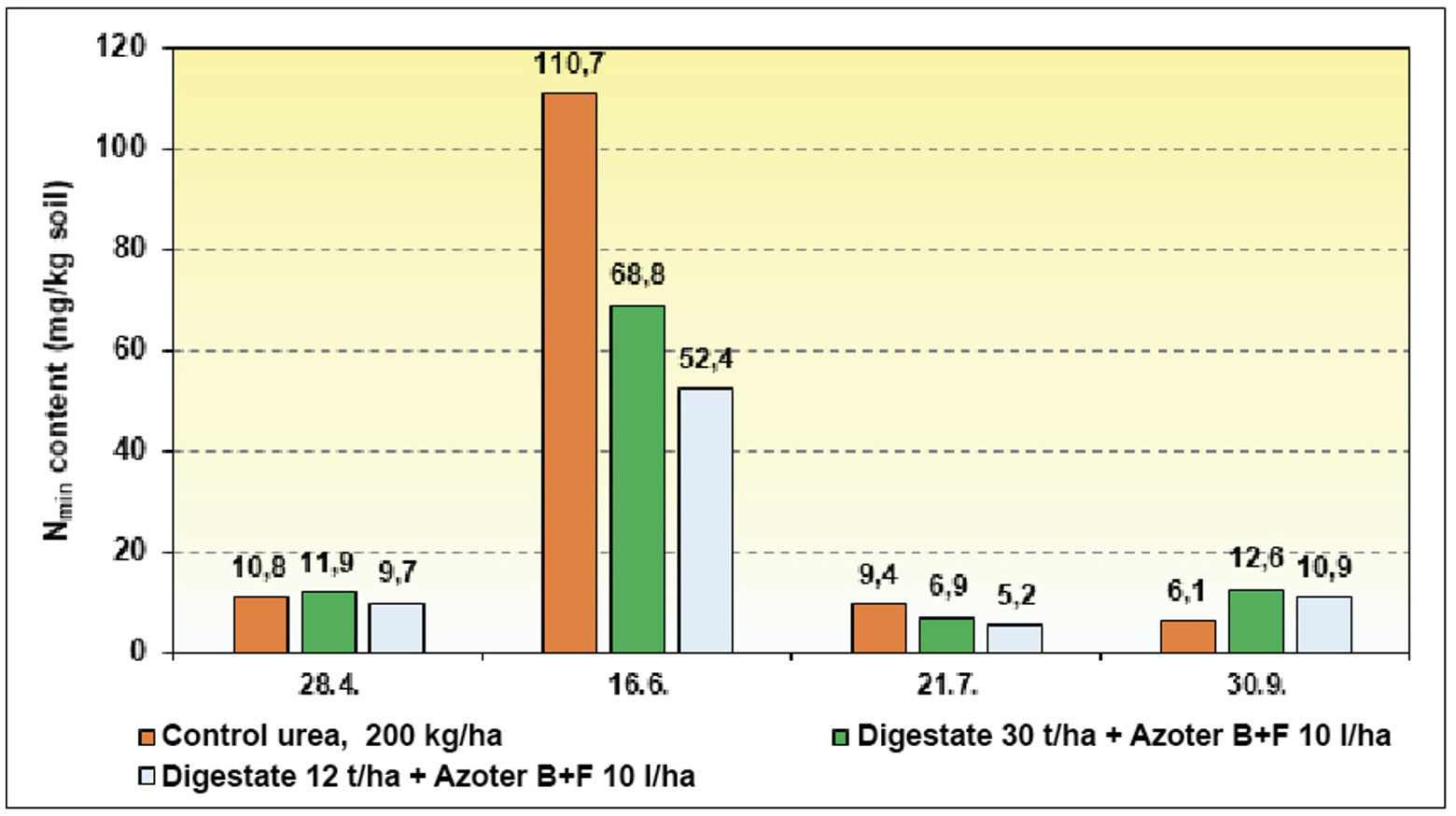
Graph 1. The effect of AZOTER B + F application and the application of the digestate from the biogas plant before sowing on the dynamics of the mineral nitrogen content (Nmin) in the soil (Habry, application performed on 12.-13. 5. 2021)
After digestate application at the end of the maize vegetation, soil treated with AZOTER B + F bacterial fertilizer showed the improvement of the agrochemical properties for the targeted microbial support of nutrients released from less accessible compounds. Especially after combination of AZOTER B + F with a full dose of digestate 30 t / ha, there was an increase in the available phosphorus content by 14 mg / kg (77%), potassium by 15 mg / kg (8%), and calcium by 108 mg/ kg (7%), magnesium by 24 mg / kg (20%), compared to standard nitrogen urea fertilization. After digestate application at a dose of 30 t / ha together with AZOTER B + F fertilizer, the soil pH has been improved minimally (by 0.2) compared to conventional urea fertilization. At the end of maize growing, the soil pH decreased after all fertilization variants by pH 0,5 – 0,7. In connection with making macro-elements accessible, microbial release of microelements was found after digestate application at a full dose of 30 t / ha. The available iron (Fe) content increased by 16 mg / kg (6%) and zinc (Zn) by 0.19 mg / kg (6%). However, there was also an increase in available aluminum (Al) content by 54 mg / kg (6%), which may reduce the subsequent mobility (availability) of released phosphorus in the soil.
Digestate application at a reduced dose of 12 t / ha to the soil with bacterially promoted release from less available forms of nitrogen and microelements with AZOTER B + F fertilizer resulted in an increase in the available phosphorus content by 2 mg / kg (11%) and potassium by 6 mg / kg (3%). After the reduced dose of digestate to 12 t / ha, elements such as calcium and magnesium were not indicated in the soil. The content of calcium (-8%) and magnesium (-14%) in the soil was lower than after applying standard urea fertilization. The decrease in these nutrients was probably due to a higher increase in aboveground biomass for better availability of the main nutrients in maize (phosphorus, nitrogen, and zinc).
After a reduced dose of digestate to 12 t / ha, there was iron release in the soil and the content of accessible forms of Fe increased by 25 mg / kg ( 9%). After the digestate application in a substantially reduced dose to 12 t / ha, the content of available zinc (Zn) also showed an increase by 0,29 mg / kg (9%) compared to the content after standard urea fertilization. The release of aluminum (Al) in the soil was lower after a reduced dose of digestate, ie by 13 mg / kg (1%) compared to the standard application of urea.
It is evident that the intake of aluminum into the soil increased with the intensity of the digestate dose (especially after 30 t / ha). On the other hand, the higher content of iron and zinc in the soil was related to the lower intensity of the digestate dose (12 t / ha). A higher effect of accessing these elements is thanks to the targeted application of bacteria Pseudomonas putida in AZOTER B + F fertilizer. The availability of basic macro-elements in the soil at the time of maize harvest was higher after application of the larger dose of digestate (30 t / ha), especially in phosphorus and magnesium. The effect of the own dose of digestate on the supply increase was higher than the own supporting effect of bacteria in the access of phosphorus and magnesium from less accessible soil reserves (Table 3).
| Variant treatment | pH/ CaCl2 | P | K | Ca | Mg | Fe | Al | Zn |
| mg/kg soil (leachate by Mehlich III) | ||||||||
| Control, urea 200 kg/ha | 5,31 | 18 | 194 | 1455 | 121 | 284 | 932 | 3,32 |
| Evaluation: | Acidic | Very low | Good | Satisfactory | Satisfactory | Good | Very high | Good |
| Digestate 30 t/ha + Azoter B+F 10 l/ha | 5,52 | 32 | 209 | 1563 | 145 | 300 | 986 | 3,51 |
| Evaluation: | Acidic | Low | Good | Satisfactory | Satisfactory | Good | Very high | Good |
| Digestate 12 t/ha + Azoter B+F 10 l/ha | 5,34 | 20 | 200 | 1339 | 104 | 309 | 945 | 3,61 |
| Evaluation: | Acidic | Very low | Good | Satisfactory | Low | Good | Very high | Good |
| Urea change / digestate 30 t/ha: | 177 % | 108 % | 107 % | 120 % | 106 % | 106 % | 106 % | |
| Urea change / digestate 12 t/ha: | 111 % | 103 % | 92 % | 86 % | 109 % | 101 % | 109 % | |
Table 3. The effect of AZOTER B + F bacterial fertilizer and digestate application from biogas plant before sowing on soil pH and the content of accessible nutrients in the soil (Habry before harvest on 30. 9. 2021)
The nutrition of maize plants during the growing season was significantly affected by the type of applied fertilizers and partly by AZOTER B + F soil adjuvant. In the period of stand emergence, in the stage of the developed 4th-5th leaf (BBCH 14 – 15), after the soil was treated with the supporting AZOTER B + F bacterial fertilizer and after subsequent application of organic fertilizer digestate in full (30 t / ha) and reduced dose (20 and 12 t / ha) there was an improvement of the nutritional status of plants with basic nutrients.
The nutritional status of plants with nitrogen (N) was indicated after area application at the level of medium deficit (83% optimum), after digestate application at full dose 30 t / ha and soil treatment with AZOTER B + F bacterial fertilizer at the level of mild deficit (91% optimum), after digestate application at a reduced dose of 20 t / ha and soil treatment with AZOTER B + F fertilizer at the level of a slight deficit (92% optimum) and after application of a significantly reduced dose of digestate to 12 t / ha in combination with soil treatment with AZOTER B + F fertilizer at the level of a very modest deficit (95% optimum). Plant nutrition with phosphorus (P) after standard urea fertilization was indicated at the level of very deep deficit (47% optimum), after soil treatment with AZOTER B + F bacterial fertilizer in combination with digestate dose of 30 t / ha at the level of deep deficit (53% optimum) , in combination with a dose of 20 t / ha at the level of the deep deficit (51% optimum) and in combination with a significantly reduced dose of digestate of 12 t / ha at the level of the deep deficit (53% optimum). Plant nutrition with phosphorus was the main limiting (deficient) element at the time of stand emergence (symptoms listed in the appendix). The nutritional status of the plants with potassium (K) was indicated after urea application at the level of medium deficit (83% optimum), after soil treatment with AZOTER B + F fertilizer and digestate application at a dose of 30 t / ha at the level of optima (99% optimum), after digestate application at a dose of 20 t / ha over the optimum (103% optimum) and after application of the lowest dose of digestate 12 t / ha at the optimum level (98%). Plant nutrition with Calcium (Ca) was indicated in the optimum level only in a slight excess (106-112% optimum) in all fertilization variants. After the application of a full dose of digestate 30 t / ha, the nutritional status of plants with calcium was indicated to be the lowest (but in the optimum). The nutritional status of plants with magnesium (Mg) was indicated to be the second limiting element of plant nutrition. After urea application, magnesium nutrition was at the limit of very deep and deep deficits (51% optimum), after the soil treatment with AZOTER B + F fertilizer and application of a full dose of digestate 30 t / ha, plant nutrition with magnesium was in deep deficits (57% optimum). The nutrition of the plants with magnesium after the reduced doses of digestate of 20 and 12 t / ha was also at the level of a deep deficit (both 60% optimum). Plant nutrition with Zinc (Zn) was indicated to be in a deep deficit after urea application (53% optimum), after soil treatment with AZOTER B + F fertilizer and a full dose of digestate of 30 t / ha, the plant nutrition with zinc was indicated to be at the level of medium deficit (83% optimum), after AZOTER B + F application and a reduced dose of digestate of 20 t / ha at the level of the deep deficit (59% optimum) and after AZOTER B + F application and a highly reduced dose of digestate of 12 t / ha at the level of the medium deficit (75% optimum). At the time of stand emergence, plant nutrition was significantly better at all doses of digestate, with evident support of microbial nutrient release by pre-applied AZOTER B + F fertilizer (Graph 2).
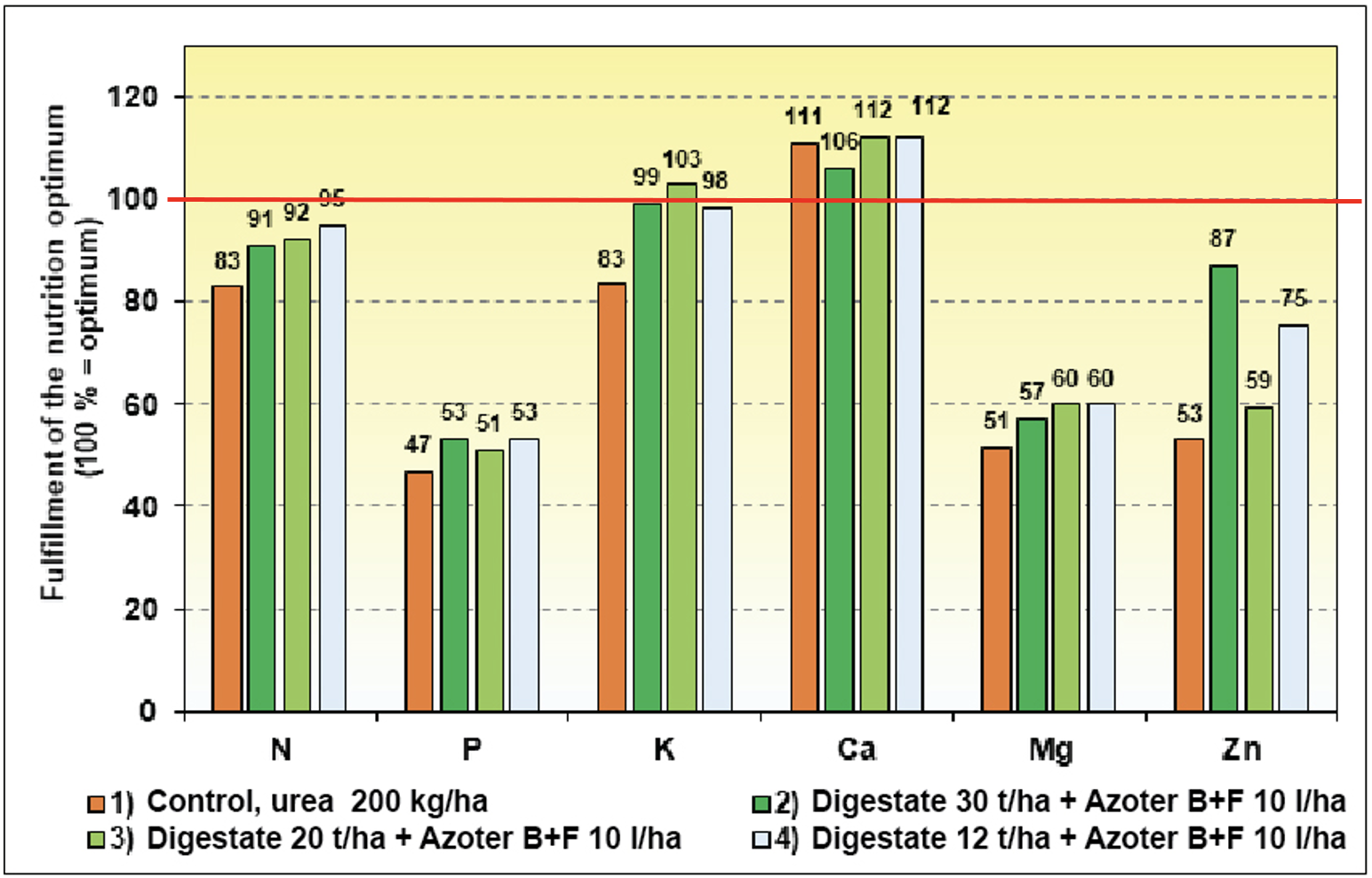
Graph 2. The effect of AZOTER B + F bacterial fertilizer and digestate application from the biogas plant before sowing on the nutritional status of maize plants in the period of crop involvement, in the stage of the developed 4th-5th leaf (Habry, 16. 6. 2021)
In the intensive growth of maize stands (in the stage of developed 4th – 6th node, BBCH 34 – 36) a better nutritional status of maize plants persisted after microbial treatment of the soil with AZOTER B + F fertilizer and with the digestate application for comprehensively supported nutrient availability. Plant nutrition with nitrogen (N) after application of standard urea fertilizer was indicated at the level of a slight deficit (95% optimum), after soil treatment with AZOTER B + F and digestate application at a dose of 30 t / ha at a level of slight excess (105% optimum), after application of a reduced digestate dose of 20 t / ha at a level of slight excess (104% optimum) and after soil treatment with AZOTER B + F and application of a substantially reduced digestate dose of 12 t / ha at a level of excess (111% optimum). The nutritional status of the plants with phosphorus (P) was indicated after urea application at the level of the optimum (104% optima). After soil treatment with AZOTER B + F and subsequent digestate application at the dose of 30 t / ha, plant nutrition was at the level of optimum (104% optima), after a dose of 20 t / ha and after a dose of 12 t / ha the nutritional status was at the level of a slight deficit (93% optima). The nutritional status of the plants with potassium (K) after urea application was indicated at a very high level of premium intake (excess = 140% optimum). After the soil treatment with the supporting AZOTER B + F bacterial fertilizer and subsequent digestate application at a dose of 30 t, 20 t and 12 t / ha, the plant nutrition with potassium showed a gradual high to very high excess (172, 181 and 190% optimum). It was assumed that potassium was more available after lower doses of digestate to the plants. The nutritional status of the plants with calcium (Ca), after urea application (68% optimum), was indicated at the level of a deep deficit. After the soil treatment with AZOTER B + F fertilizer and digestate application at a dose of 30 t / ha, calcium nutrition of plants was indicated at the level of mild deficit (94% optimum), after digestate application at a dose of 20 t / ha, the nutrition was at the level of medium deficit (86% optimum) and after digestate application at a substantially reduced dose of 12 t / ha the nutrition was at a level of mild deficit (90% optimum). After urea application, nutrition of the plants with magnesium Mg (56% optima) was indicated to be deeply deficient. The nutrition of plants with magnesium after the soil treatment with AZOTER B + F bacterial fertilizer and digestate application at the full dose of 30 t / ha was indicated at the level of better deep deficit (68% optimum), after digestate application in the reduced dose of 20 t / ha and in dose of 12 t / ha, magnesium nutrition was consistently in deep deficit (60% optimum). The nutritional status of plants with zinc (Zn) was the main nutritional deficient element in the intensive growth of maize. After urea application, plant nutrition with zinc was indicated at the level of a very deep deficit (49% optimum). After the soil treatment with supporting AZOTER B + F bacterial fertilizer and subsequent application of digestate in the full dose of 30 t / ha, plant nutrition was indicated in a deep deficit (59% optimum), after a dose of digestate 20 t / ha, plant nutrition was at the level of medium deficit (71% optimum) and after the application of a substantially reduced digestate dose to 12 t / ha, plant nutrition was at a deep deficit level (59% optimum). The application of the supporting AZOTER B + F microbial preparation and the subsequent complex of digestate fertilizer contributed to better plant nutrition in its intensive growth (Graph 3).
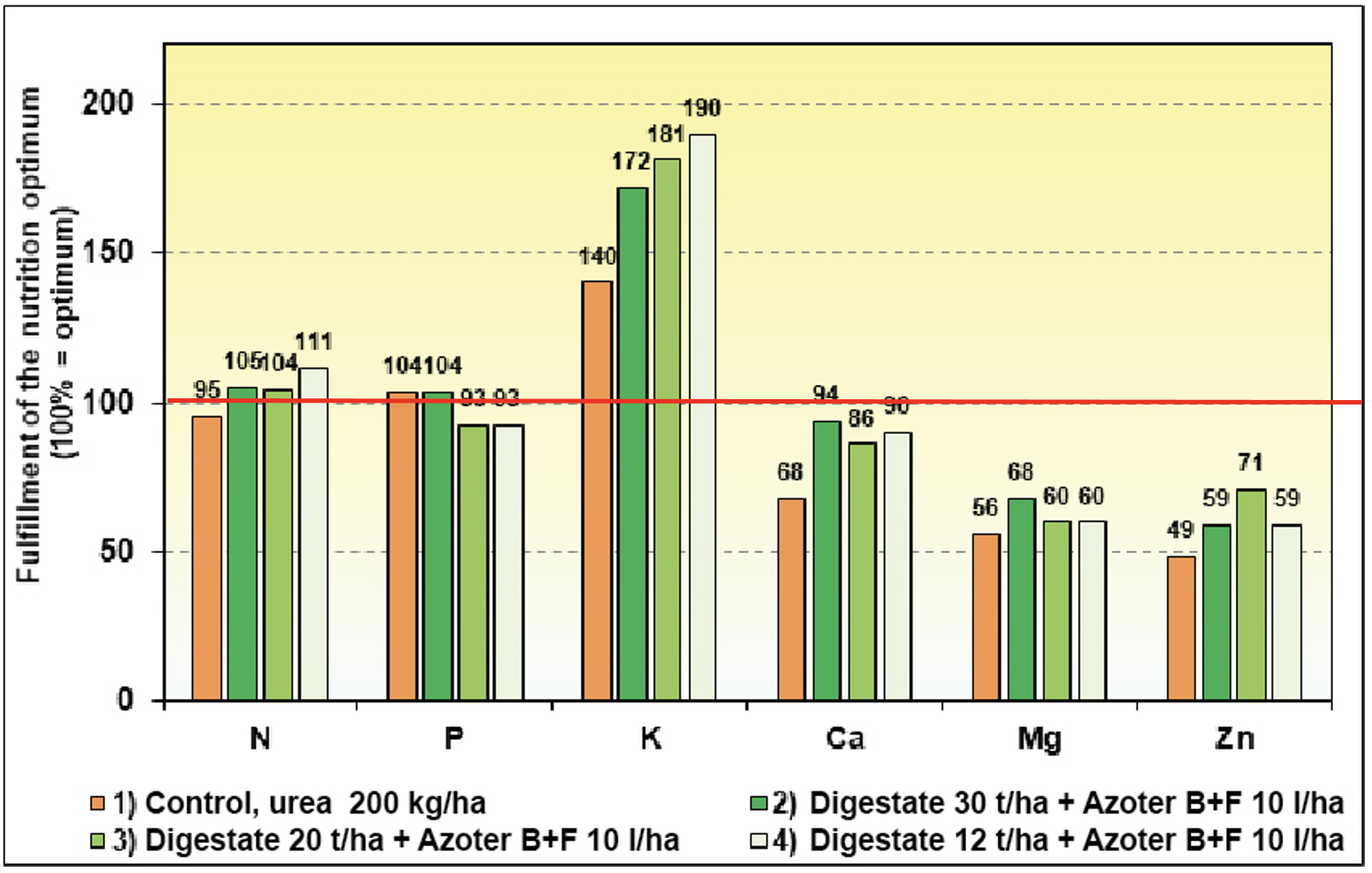
Graph 3. The effect of AZOTER B + F bacterial fertilizer and the digestate application from the biogas plant before sowing on the nutritional status of maize plants in the period of intensive growth, in the stage of the developed 4th-6th node. (Habry, July 21, 2021)
Better nutritional status of maize stands during vegetation after biologically supported releasability of nutrients in the soil after applying AZOTER B + F bacterial fertilizer together with digestate application had a positive effect in the yield and quality of harvested forage. After standard nitrogen fertilization with urea before sowing, the yield of fresh forage was 36.5 t / ha. After the soil was treated with AZOTER B + F bacterial fertilizer and subsequent application of the full dose of digestate 30 t / ha, a significantly higher forage yield of 61.7 t / ha was achieved. After the soil was treated with AZOTER B + F and after applying a reduced dose of digestate of 20 t / ha, a forage yield of 42.2 t / ha was indicated. After the soil treatment with AZOTER B + F bacterial fertilizer and after a substantially reduced dose of digestate to 12 t / ha, the yield of fresh forage was 65.8 t / ha. After application of the standard urea fertilizer, the yield of the main nutrient component of forage, starch, was indicated in amount of more than 3.5 t / ha. After treating the soil with AZOTER B + F and applying the digestate dose of 30 t / ha, the starch yield increased to more than 6.2 t / ha. After treating the soil with AZOTER B + F and applying a reduced digestate dose of 20 t / ha, the starch yield dropped to almost 3.3 t / ha. After treating the soil with AZOTER B + F and applying a significantly reduced dose of digestate to 12 t / ha, the starch yield increased to 5.5 t / ha. The yield of nitrogenous substances (N-substances) in the forage was indicated after urea fertilization of 0.9 t / ha. After the soil treatment with AZOTER B + F bacterial fertilizer and subsequent application of digestate in a dose full of 30 t / ha, the yield of N-substances increased to more than 1.5 t / ha, after a reduced dose of digestate 20 t / ha the yield of N-substances reached less than 1.2 t / ha and after the soil treatment with AZOTER B + F and application of digestate at a dose of 12 t / ha, the yield of N-substances increased to almost 1.5 t / ha.
After the soil treatment with AZOTER B + F bacterial fertilizer and after the application of a medium dose of digestate of 20 t / ha, a significantly smaller change in forage yield was affected by an experimental defect (damage of the vegetation caused by game). It can be assumed that after the digestate dose 20 t / ha, the achievable forage yield would reach a yield value between 30 and 12 t / ha of digestate dose. The reduced digestate dose to 12 t / ha using the supporting AZOTER B + F fertilizer to release the nutrient from the digestate and from the soil supply, resulted in a comparable increase in yield with the full digestate dose of 30 t / ha, compared to standard urea fertilization. It´s evident, that in the technology of microbial revitalization of soil with AZOTER B + F, a 60% lower dose of organic fertilizer digestate was sufficient for the forage yield production and the yield of basic nutrients for animal feed recipes (Graph 4).
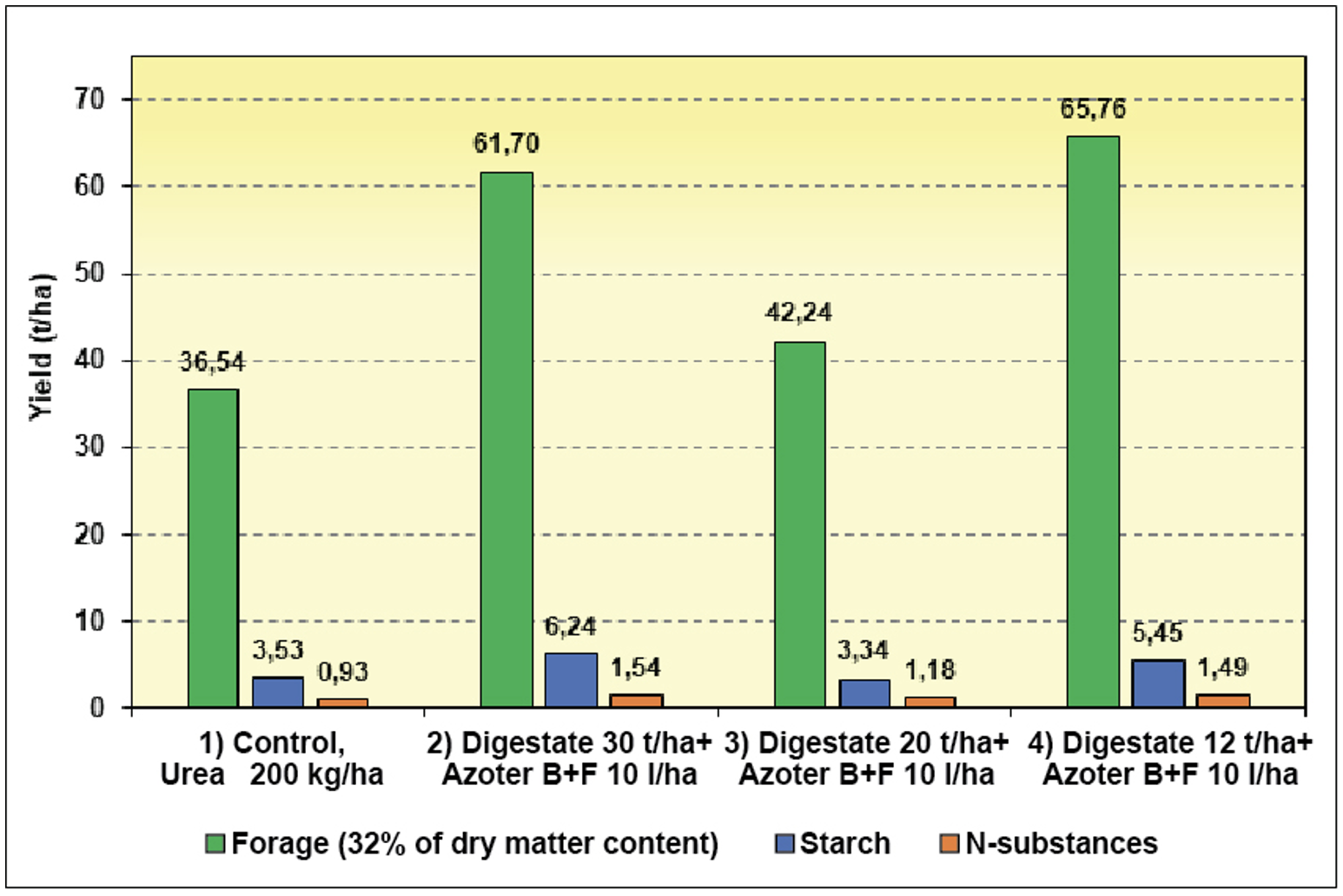
Graph 4. The effect of AZOTER B + F bacterial fertilizer and the digestate application from the biogas plant before sowing on the yield of fresh forage, starch and N-substances in the forage (Habry, October 16-17, 2021)
| Soil treatment and fertilization before sowing the maize | Harvested area | Fertilizer dose | Reduction of N dose | Forage yield | Starch yield | Yield of N-substances |
| 1) Control, urea 200 kg/ha | 6,67 ha | 92 kg N/ha | — | 100 % | 100 % | 100 % |
| 2) Digestate 30 t/ha + AZOTER B+F 10 l/ha | 4,77 ha | 81 kg N/ha | 12 % | 169 % | 177 % | 166 % |
| 3) Digestate 20 t/ha + AZOTER B+F 10 l/ha | 4,67 ha | 54 kg N/ha | 41 % | 116 % | 95 % | 127 % |
| 4) Digestate 12 t/ha + AZOTER B+F 10 l/ha | 4,10 ha | 32 kg N/ha | 65 % | 180 % | 154 % | 160 % |
Forage yield formation was analyzed 16 days before harvesting. Plants after the application of organic digestate fertilizer with supported microbial release of nutrients in the soil by previous soil treatment with AZOTER B + F were longer than plants after standard nitrogen urea fertilization. The applied reduced doses of digestate to 20 and 12 t / ha after the soil treatment with AZOTER B + F resulted in a slightly higher use of grain sticks compared to the full dose of digestate 30 t / ha and compared to urea fertilization. On the other hand, the highest average weight of cobs was indicated after the application of standard urea fertilizer. Related to this, the structure of graining of the maize cobs showed the highest number of 16 pieces rows of grains after basic urea fertilization. However, after the soil treatment with AZOTER B + F bacterial fertilizer and subsequent digestate application in the full dose of 30 t / ha and in the lowest dose of 12 t / ha, the number of grains in rows (related to the length of cobs) was the highest (34 pieces). After the soil treatment with AZOTER B + F followed by the digestate application at a rate of 30 t / ha, thousand grain weight (TKG) was the highest (395 g). The second highest thousand grain weight (TKG) of 362 g was recorded after standard urea fertilization.
It is evident that the microbial treatment of the soil with AZOTER B + F and the application of organic fertilizer digestate to support the release of nutrients affected the extension of plant length at the end of intensive growth. The detected higher final supply of soil and plants with nitrogen (nutrients) supported the formation of a larger number of cobs on plants, which, however, showed a smaller number of grain rows on average, but a higher number of grains in rows. Larger TKG was only after the highest dose of digestate, which, however, did not contribute to the highest achievement of forage yield. After the soil treatment with AZOTER B + F bacterial fertilizer and after the subsequent digestate application from the biogas plant, the main element of yield forage production was longer plant length and the potential for higher use of graining of the maize cobs (Table 4).
| Variant treatment | Yielding element | |||||
| Lenght of plants (cm) | Cobs (pcs/ plant) | Weight of cobs on the plant (g/pcs) | No. of rows (pcs/ cobs) | No. of grains (pcs/ row) | TKG (g) | |
| 1) Control, urea 200 kg/ha | 327 | 1,5 | 329 | 16,0 | 31,7 | 362 |
| 2) Digestate 30 t/ha + Azoter B+F 10 l/ha | 350 | 1,4 | 291 | 13,3 | 34,0 | 395 |
| 3) Digestete 20 t/ha + Azoter B+F 10 l/ha | 346 | 1,8 | 252 | 13,0 | 30,5 | 321 |
| 4) Digestate 12 t/ha + Azoter B+F 10 l/ha | 331 | 1,6 | 290 | 14,0 | 34,0 | 347 |
Tab. 4. The effect of the application of AZOTER B + F bacterial fertilizer during the digestate application from the biogas plant before sowing on the formation of maize yield (Habry)
The quality of forage maize was due to the above-average summer precipitation, for the final release of nutrients after the soil treatment with AZOTER B + F bacterial fertilizer and after the digestate application positively affected. The stands were harvested later, at the end of the harvest period. Standard urea fertilization of the soil was reflected in the stand, by earlier ripening (water loss) at harvest and due to a higher dry matter content of 37,7%, which already indicated an increased risk for silage (5,7% at optimum level). After nitrogen fertilization with urea, a small supply of nitrogen (Nmin) was found in the soil and the stand moved faster to finish the vegetation period. After the digestate application with previous microbial support (AZOTER B + F) of nitrogen release in the soil, lower dry matter contents were found in the forage, which were more favorable for silage. After the soil treatment with AZOTER B + F bacterial fertilizer and after digestate application in a full dose of 30 t / ha, the dry matter content in the forage was 36,2% (4,2% above the optimum level). After the digestate application in a reduced dose of 20 t / ha, dry matter content in the forage decreased by 5,7% (1,6% below the optimum level). After applying a significantly reduced dose of digestate 12 t / ha, the dry matter content decreased by less than 2% (2,3% above the optimum level). After the soil treatment with AZOTER B + F bacterial fertilizer and subsequent application of reduced doses of digestate, the stands showed a lower starch content, which could be related to the supportive effect of the final nitrogen release in the soil. After the reduced doses of digestate, the stands showed delayed maturity and water loss for improved nitrogen nutrition. By delaying the harvest, it would have been possible to complete the assimilation and transformation of simple sugars in the plant into starch in the grain. In the practical technological impact, it is evident that for the soil treatment with AZOTER B + F before the digestate application, it is effective to observe the timely establishment of the corn stand. The content of nitrogenous substances (N-substances) in the forage was minimally different between the treatment variants and fertilization of the soil for the stand establishment (Table 5).
| Variant treatment | Forage content (%) | ||
| Dry matter | Starch (in dry matter) |
N-substances (in dry matter) |
|
| 1) Control, urea 200 kg/ha | 37,68 | 30,22 | 7,94 |
| 2) Digestate 30 t/ha + Azoter B+F 10 l/ha | 36,21 | 31,59 | 7,82 |
| 3) Digestate 20 t/ha + Azoter B+F 10 l/ha | 30,42 | 24,69 | 8,76 |
| 4) Digestate 12 t/ha + Azoter B+F 10 l/ha | 34,25 | 25,90 | 7,06 |
Tab. 5. The effect of AZOTER B + F bacterial fertilizer application and the digestate application from the biogas plant before sowing on the formation of maize yield (Habry)
Economic evaluation: Application of a wide range of native soil bacteria with enhanced content of mineralizing bacteria Pseudomonas putida and phytosanitary parasitic fungus Trichoderma atroviride fully included in AZOTER B + F, in the period before subsequent application of digestate from biogas plant, had a positive effect in economics of silage maize growing process. After the soil treatment with the concentrated AZOTER B + F bacterial fertilizer with immediate incorporation into the soil and subsequent application of a reduced dose of nitrogen in the digestate from the biogas plant before sowing the maize, the economic and ecological benefits were achieved:
| Fertilization variant, +support of nutrient release in soil |
Dose reduction N (100 %
= control
Intracompany revenue
(current pricing)
Fertilizer costs
(original price)Application costs
(current pricing)Contribution towards other expenses1) Control,
urea 200 kg/ha,
without support–18.270 CZK/ha1800 CZK/ha350 CZK/ha16.120 CZK/ha2) Digestate 30 t/ha
+ Azoter B+F 10 l/ha
12 %
(11 kg N/ha)
30.850 CZK/ha1350 + 900 CZK/ha2800 + 200 CZK/ha25.600 CZK/ha3) Digestate 20 t/ha
+ Azoter B+F 10 l/ha
41 %
(38 kg N/ha)
21.120 CZK/ha900 + 900 CZK/ha2200 + 200 CZK/ha16.920 CZK/ha4) Digestate 12 t/ha
+ Azoter B+F 10 l/ha
65 %
(60 kg N/ha)
32.880 CZK/ha540 + 900 CZK/ha1600 + 200 CZK/ha29.640 CZK/ha
Note: The calculation includes current pricing, ie intracompany product: 1 t of maize silage = 500 CZK, digestate (1 t = 45 CZK) = 16,7 CZK / kg N, intracompany valuation of machine works – application with industrial fertilizer spreader (urea), sprayer (AZOTER B + F fertilizer), applicator of liquid organic fertilizers. Original purchase prices of nitrogen in urea (9.000 CZK/ t) = 19.,6 CZK / kg N.
Conclusion
Standard soil fertilization with urea mineral fertilizer for establishing the maize stands showed a strong effect on the pre-supply of the soil with mineral nitrogen (Nmin) after the stand emerged. In plant nutrition, however, in the period of the developed 4th – 5th leaf, digestate fertilization from the biogas plant into the soil with microbially supported release of nutrients with AZOTER B + F fertilizer, which contains a wider range of economically beneficial bacteria, was significantly better. After the soil treatment with AZOTER B + F and after the digestate application, better nutritional status of the stands continued in their intensive growth (in the developed 4th – 6th node). Supported decomposition of organic matter and in terms of nutrient availability for plants, higher mineralization activity of bacteria supplied the plants with nutrients more intensively. The supported release of nitrogen from the digestate and from the organic compounds of the soil supply by AZOTER B + F, contributed to the increase of the Nmin content in the soil at the end of the vegetation. Higher Nmin supply in the soil, after microbial enhancement of the fertilizing efficiency of the digestate, supported the production of yield by longer plant length, slightly higher number of grained cobs, higher number of grains in rows on the cobs and higher thousand grain weight (TKG) after the highest dose of digestate 30 t / ha. The applied dose of digestate 30 t / ha after the soil treatment with AZOTER B + F bacterial preparation in the dose of 10 l / ha with the addition of separate additive F in the dose of 0.1 l / ha showed the greatest benefit in terms of yield, forage quality and generated nitrogen savings, compared to the standard nitrogen fertilization in urea fertilizer. After the soil treatment with AZOTER B + F and subsequent digestate application, soil fertility increased. This measure increased the supply of soil with accessible phosphorus, potassium. This measure also increased the supply of soil with accessible microelements such as zinc and iron for the subsequent crop.
Direct delivery of the original economically important bacteria (Azotobacter chroococcum, Azospirillum brasilense, Bacillus megaterium and Pseudomonas putida) to the soil and parasitic fungi (Trichoderma atroviride) with AZOTER B + F to support the decomposition of labile and variously stabilized organic substances and targeted increase of fertilizer digestate efficiency, showed the possibility of reducing the application rates of nitrogen for the demanding maize crop by 12-65% compared to standard basic fertilization with nitrogen in mineral fertilizers (urea). In the used technology of spring fertilization of maize with digestate, after previous or simultaneous treatment of the soil with the concentrated AZOTER B + F bacterial fertilizer it is possible to calculate with a fertilizer saving of 33 – 60% while maintaining or improving forage yields. By saving a dose of digestate, it is also possible, to reduce the time required for the transport and the application, which practically enables the timely sowing of maize during the spring peaks of work operations.
_______________________
The results of the tested AZOTER B + F bacterial fertilizer were obtained in 2021 from an established operational experiment in the implementing agricultural company, for the client AZOTER CZ s.r.o. The results of the experiment were provided to the representatives of the implementing company.
In Žamberk on November 10, 2021
Photo annex.
A)
Demonstration of a very deep phosphorus deficiency in plants (47% of optimal content) after standard urea fertilizer application (on the left) and deep phosphorus deficiency in plants (53% of optimal content) after digestate application from biogas plant in the soil supported with microbial release of nutrients by AZOTER B + F bacterial fertilizer (on the right) – 6. 2021, BBCH 14-15
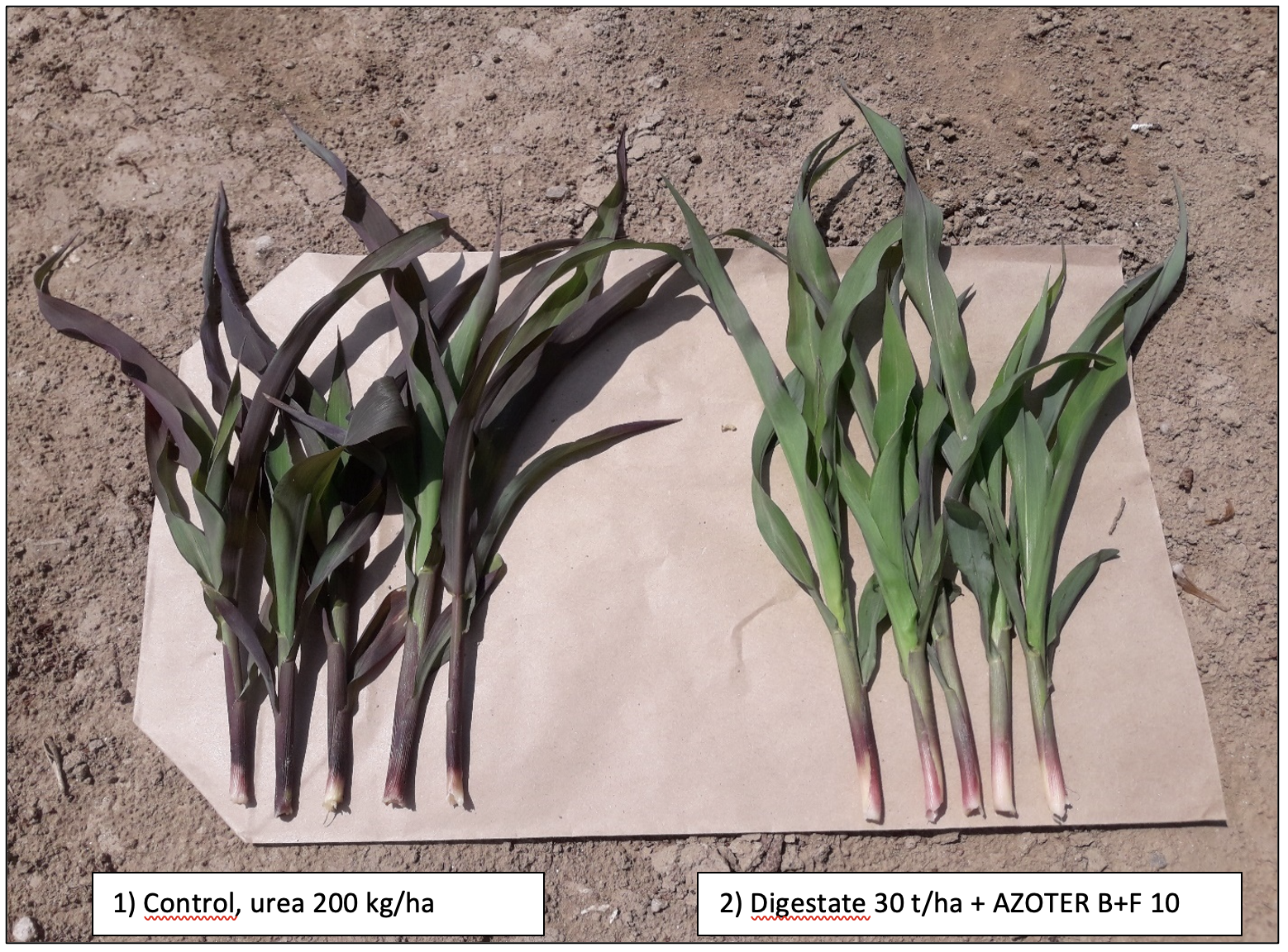
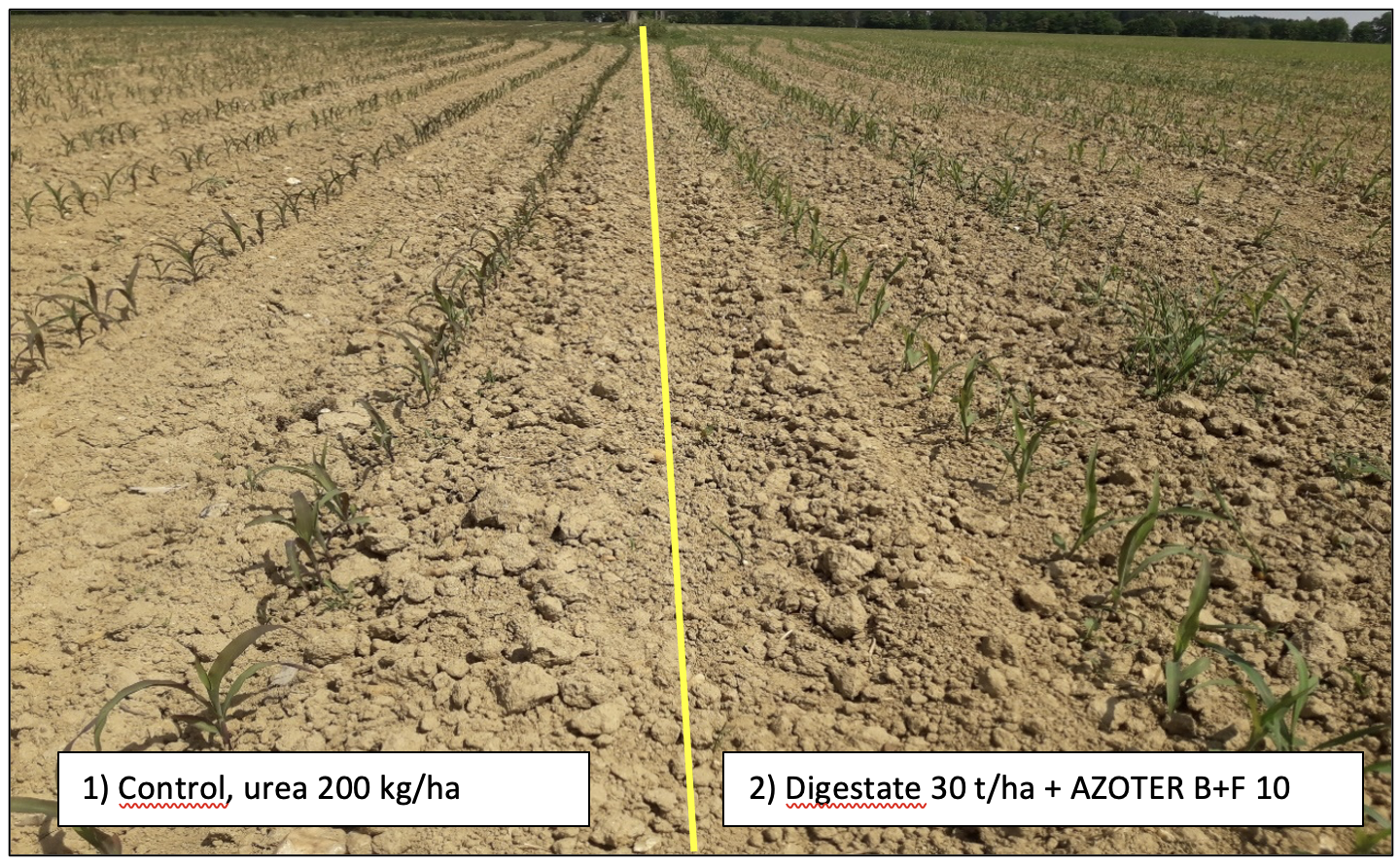
B)
Demonstration of different growth rates: after application of standard urea fertilizer (on the left) and after digestate application from biogas plant with supported microbial release of nutrients in soil by AZOTER B + F bacterial fertilizer (on the right) – 7. 2021, BBCH 34-36
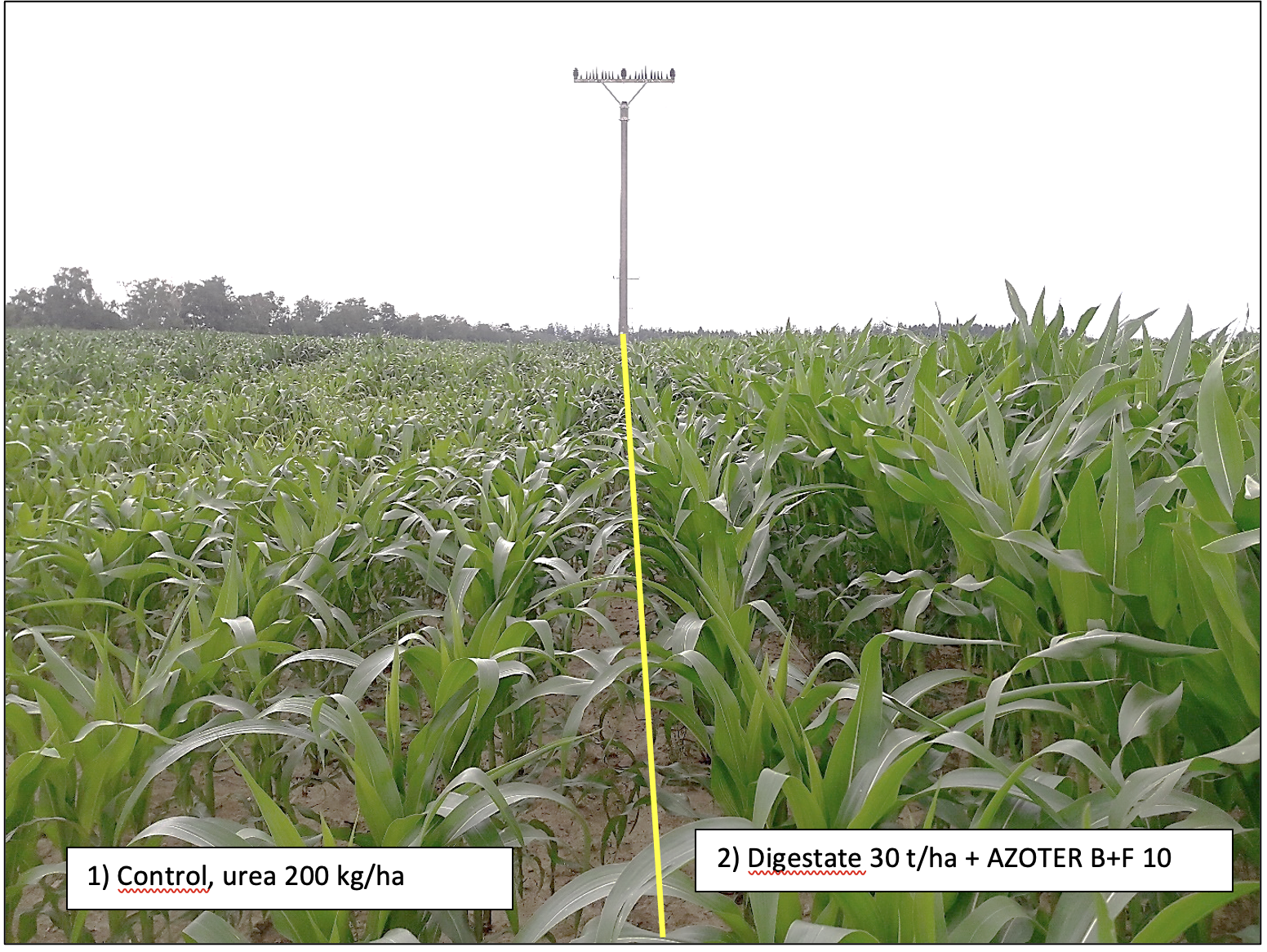
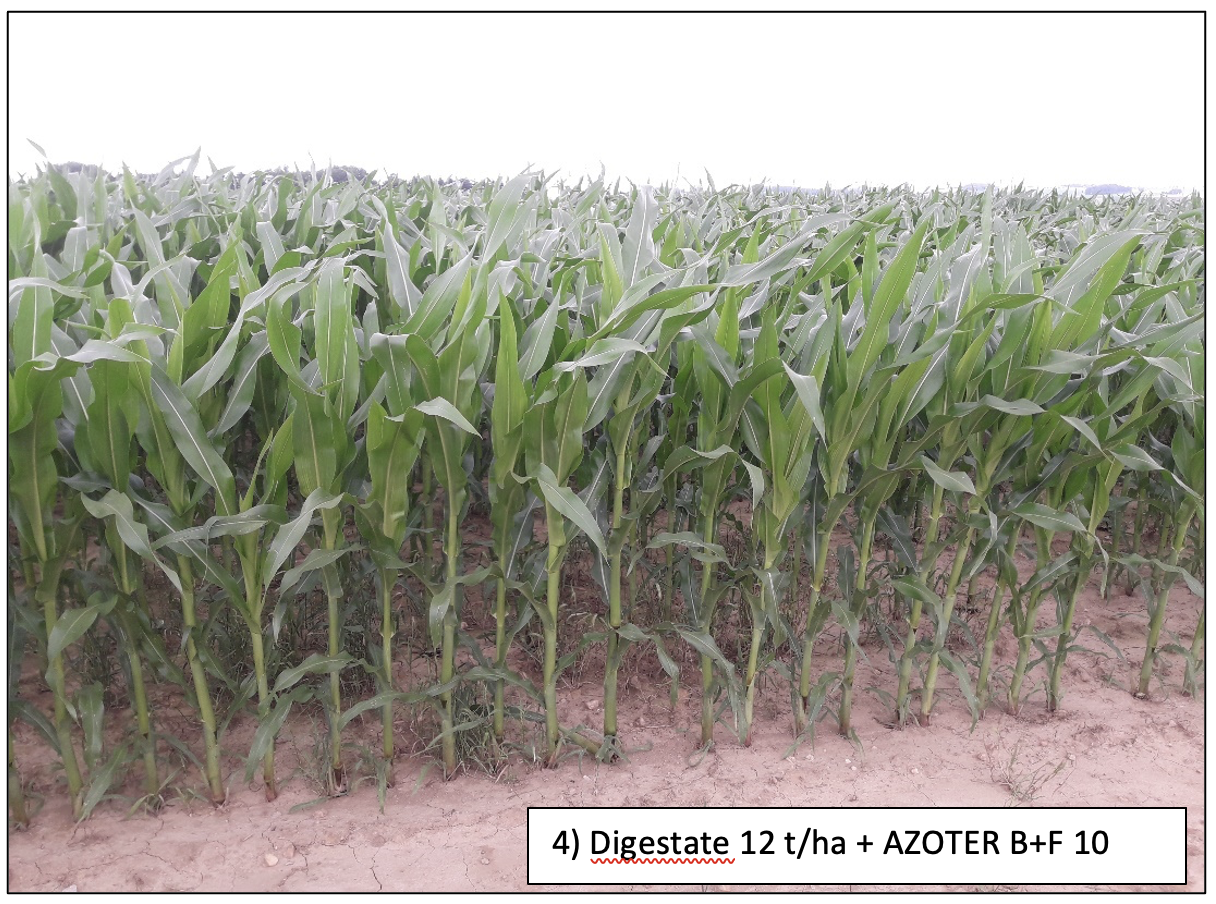
C)
Demonstration of different ripeness of stands (dry matter content): After standard urea fertilizer application (on the left) and after application of digestate from biogas plant (30 t / ha) with supported microbial release of nutrients in the soil by AZOTER B + F bacterial fertilizer, (on the right) – 9. 2021, BBCH 75-83
